Last Updated on July 4, 2023
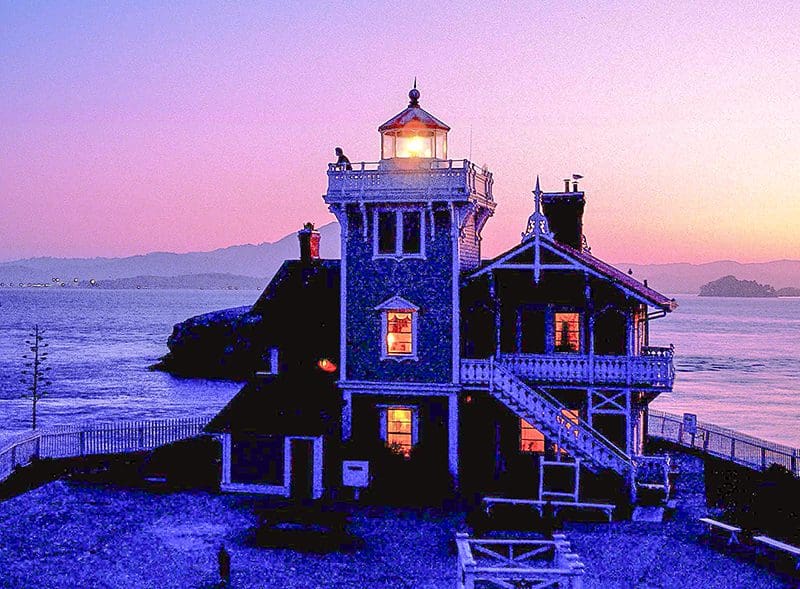
By Ray Jones
Ray Jones is an expert on U.S. lighthouses. He is the author of four books on the subject,
including Lighthouses of New England, Lighthouses of the Southern States,
Lighthouses of the Great Lakes, and Lighthouses of the West Coast.
Very likely tucked away among your most pleasant memories is an evening stroll along a U.S. beach with the flash of a lighthouse beacon calling from a distance.
Increasingly, American travelers are answering that call by including U.S. lighthouses among their destinations. Romantic, historical, and invariably graced with a gorgeous setting, American lighthouses are also wonderful places for a road trip.
In addition to all the above, lighthouses offer visitors a refreshing dose of authenticity. In fact, there is little contrived or touristy about them. (Readers should note that the U.S. as of July 2023 the U.S. government is giving away or auctioning several lighthouses in New England).
Having survived storms and pounding waves for up to two centuries, many of these visually impressive structures are still doing the job for which they were initially built, that of guiding vessels along the coast and away from dangerous reefs, sandbars, and other dangerous obstacles.
Included below are more than a dozen especially interesting and scenic American lighthouses. Since it’s impossible to include all those in America, you can add your favorites in the comments at the end of this story.
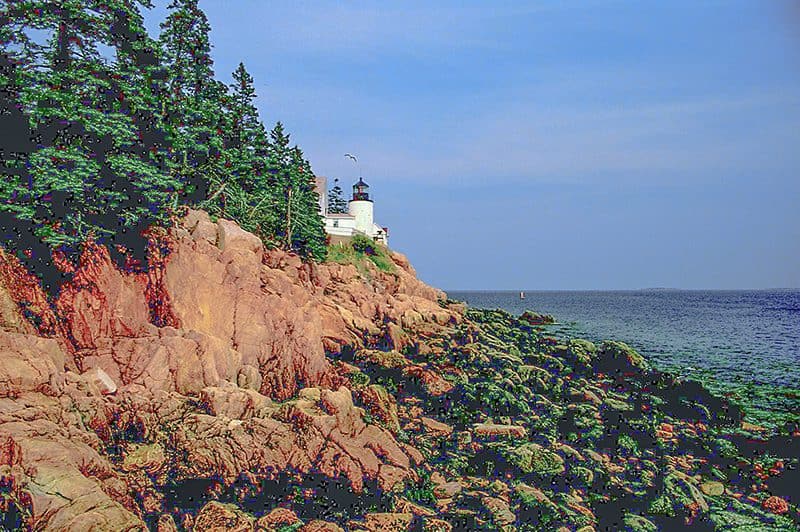
Bass Harbor Head, Maine (1858)
Among the most picturesque U.S. lighthouses, Bass Harbor Head Light is seen and photographed yearly by countless thousands of visitors to Acadia National Park. Clinging to a rocky promontory, the structure consists of a small white tower attached to a modest dwelling.
Established before the Civil War, the light marks the entrance to Blue Hill Bay on the west side of Mount Desert Island. It also assists vessels moving in and out of Bass Harbor. Fishermen and pleasure boaters watch for its red light, which briefly winks every four seconds.
While the lighthouse is closed to visitors, they are welcome to walk the grounds and clamber over the colorful rocks that drop into the Atlantic.
This area features some of the tastiest lobster on our planet, so visitors should not leave without sampling one or more of these delicious crustaceans, perhaps accompanied by an ear of corn and a slice or two of Maine blueberry bread. Travel information is available from www.nps.gov/acad/ or a wide variety of other sources.
Bass Harbor Head Lighthouse
116 Lighthouse Road
Bass Harbor, ME 04653
Tel: (207) 288-3338
Open 9am-7pm daily
https://www.nps.gov/acad/planyourvisit/bass-harbor-head-light-station.htm
Cape Cod, Massachusetts (1828)
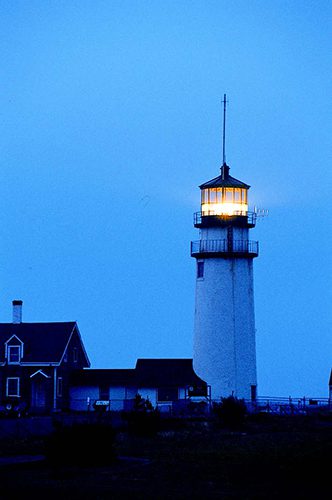
Like a whirlpool of sand in the ocean, Cape Cod sweeps seaward from the far southeast corner of Massachusetts. It then arches to the north and finally curls back on itself about 20 miles due east of Plymouth.
Deposited by glaciers that blanketed New England during much of the last 100,000 years, the sands of the Cape are constantly on the move, wearing down in one area and building up in another. The land has only a tenuous hold on this place as the ocean seems always poised to rush in and reclaim the Cape as its own.
Cape Cod is just the sort of place in the U.S. where you would expect to find lighthouses, and the Cape can boast an abundance of them. The Cape Cod Light, also known as the Highland Light, is the most prominent. The tower stands on a high bluff near Truro, and its beacon, situated 183 feet above the sea, can be seen from up to 23 miles.
For sailors emerging from the dark reaches of the Atlantic, Cape Cod Light is also often the first visual evidence that the North American continent is near. For more information on the Cape Cod Lighthouse and other nearby historic beacons, visit the National Park Service website at www.nps.gov/caco/planyourvisit/guiding-lights.htm.
Cape Cod Lighthouse
27 Highland Light Road
North Truro, MA 02652
Tel: (508) 404-9117
Open: daily 9am-5pm
https://www.highlandlighthouse.org/
Cape May, New Jersey (1824)
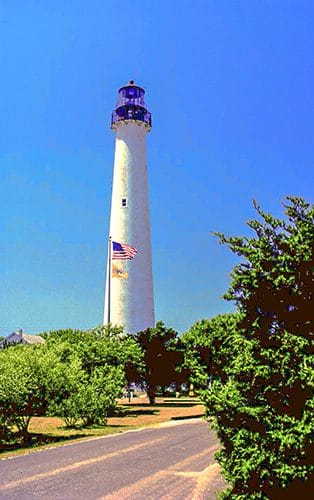
The 157-foot tower of the Cape May Lighthouse soars above the flat, sandy New Jersey coast and the blue Atlantic beyond. Although the light station was established in 1824, today’s lighthouse was built in 1859. Its distinctive white tower has faithfully served mariners and attracted admiring visitors ever since.
Like several other lighthouses in the stormy northeast U.S., it also features storm-resistant double-wall construction. The giant tower is 27 feet wide at the base and precisely half that at the top. Not surprisingly, these dimensions lend the building a graceful appearance and may account for its extraordinary stability.
On most days, visitors are welcome to climb the tower steps. It is said that more than a few marriage proposals have been offered and, one may hope, accepted at the top. Plenty of travel advice is available the National Park Service and other internet sources.
Cape May Lighthouse
215 Light House Avenue
Cape May, NJ 08204
Tel: (609) 224-6066
Open: daily 10am-4pm
https://capemaymac.org
Cape Hatteras, North Carolina (1803)
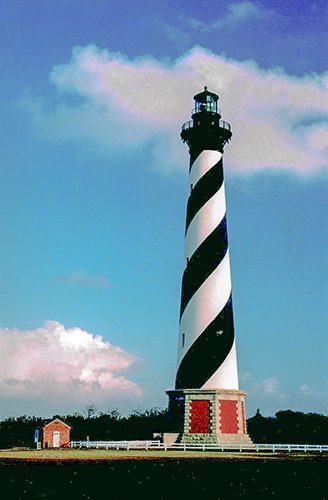
At Cape Hatteras on the North Carolina Banks stands what is likely the most famous lighthouse in America, or anywhere, but it might have vanished years ago except for an extraordinary effort in the 1990s to save it from the hungry tides. Initially, the Cape Hatteras Lighthouse was located almost a quarter mile from the ocean.
Still, storm-driven waves sweeping along the face of sandy Hatteras Island cut ever closer to the foundation of the massive tower. Eventually, the surf threatened to undermine its foundation. In fact, this historic national treasure would have toppled onto the beach if nothing had been done to save the old tower.
Fortunately for those who love U.S. lighthouses and for mariners who have depended on their guidance for more than 200 years, the Cape Hatteras Lighthouse still guides seafarers. Its light still shines each night, flashing white every 7.5 seconds from an elevation of 191 feet above high water.
In clear weather, it can be seen from 24 miles away. Listed on the National Register of Historic Places, the old lighthouse remains a much-loved attraction of the Cape Hatteras National Seashore. For information on the Outer Banks and Cape Hatteras Lighthouse visits, also check the National Park Service website at www.nps.gov/caha/.
Cape Hatteras Lighthouse
46379 Lighthouse Road
Buxton, NC 27920 (Hatteras Island)
Tel: (252) 473-2111
Open: year-round but programs change (check the Calendar for present programs/hours) at https://www.nps.gov/caha/planyourvisit/hours.htm
Ponce de Leon, Florida (1887)
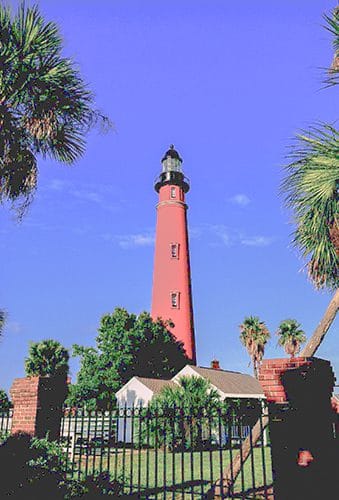
Named for the Spanish explorer who sought the fabled Fountain of Youth, the Ponce de Leon Lighthouse, with its sturdy brick tower, was completed in 1887. Its powerful flashing white light also proved extremely useful to mariners, filling an extensive 95-mile dark gap between the St. Augustine Lighthouse to the north and Cape Canaveral Lighthouse to the south. Initially, the light was produced by whale-oil lamps.
The Ponce de Leon Lighthouse is a delight for lovers of U.S. history and ocean scenery. On most days, the 168-foot tower is open and can be climbed by anyone hardy enough to manage the winding staircase.
Several of the keeper’s houses display fascinating exhibits, and together they also form one of the best lighthouse museums on the entire East Coast. On display in the lens exhibit building are a magnificent first-order lens served at the Cape Canaveral Lighthouse and a smaller but impressive third-order lens that once brightened the nearby tower.
Ponce de Leon Lighthouse
4931 South Peninsula Drive
Ponce Inlet, FL 32127
Tel: (386) 761-1821
Open: daily 10am-9pm
https://www.ponceinlet.org/
Point Isabel, Texas (1852)
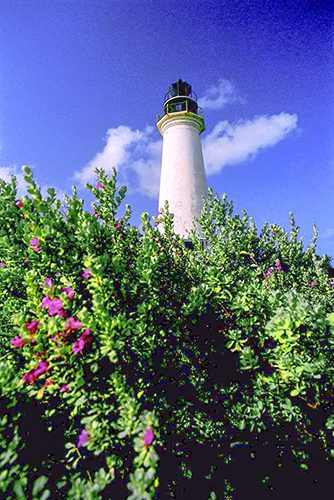
Built during the 1850s on the site of an old army camp used by General Zachery Taylor and his troops during the Mexican War, the Point Isabel Lighthouse would later provide the backdrop for the last battle of the American Civil War.
Union forces used the tower as an observation post as the blue and gray armies grappled with one another at the Battle of Palmetto Ranch on May 13, 1865. Ironically, the Southerners won the battle only to learn they had already lost the war. General Robert E Lee had surrendered at Appomattox weeks earlier.
Since it was deactivated in 1905, this U.S. lighthouse now serves as the primary attraction of a Texas state park. Even after over a century of disuse, the 57-foot brick tower and its original third-order lens remain in surprisingly good condition. Restored in 1996 for historical reasons, the lighthouse is once again operational.
Point Isabel Lighthouse
421 E Queen Isabella Boulevard
Port Isabel, TX 78578
Tel: (956) 943-0735
Open: daily 10am-9pm
http://portisabellighthouse.com
Marblehead, Ohio (1821)
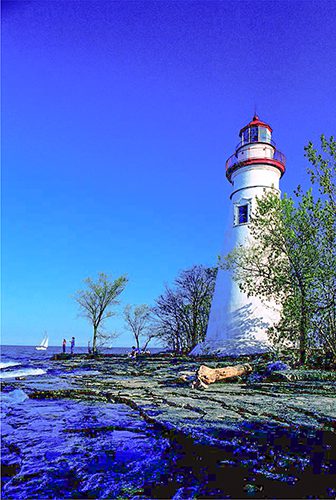
Built over 200 years ago, Marblehead Lighthouse is the oldest active navigational light on the Great Lakes. The Marblehead beacon has flashed out over a lot of history since it was placed in service in 1821, only a few years after a U.S. fleet won a decisive victory over the British at the Battle of Lake Erie. Fought just north of Marblehead in September 1813, this critical naval battle enabled the United States to retain its hold on much of the Great Lakes.
Over its more than two centuries of operation, the Marble Head beacon has guided countless large and small vessels and saved hundreds, if not thousands, of lives. During all that time, the old stone tower has changed very little. Late in the nineteenth century, its height increased from 55 to 65 feet, but otherwise, it looks much as it has since 1821. Fitted with a fourth-order lens, it displays a flashing green light.
The Marblehead Lighthouse is so historic and impressive that it merits its state park. This U.S. lighthouse and its six-acre park are a few miles east of Port Clinton, Ohio.
Marblehead Lighthouse
110 Lighthouse Drive
Marblehead, OH 43440
Tel: (419) 798-4074
Open: daily, 24 hours per day
www.marbleheadlighthouseohio.org
Big Sable, Michigan (1867)
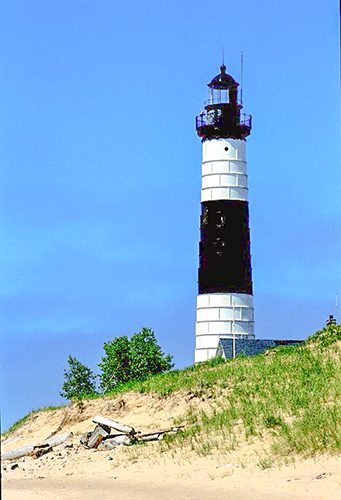
During its early days, Ludington, Michigan, had one of the most unusual fog signals in the country. A metal horn made in the shape of a long bugle stood beside a railroad track, and whenever a blanket of fog rolled in from Lake Michigan, a steam locomotive blew its whistle. Magnified by the horn, the train whistle could be heard for miles out on the lake.
Once the Big Sable Light was established just north of town in 1867, this clever but makeshift device gave way to a more conventional foghorn. Then this new U.S. lighthouse was given a 107-foot brick tower and a powerful third-order lens so that lake sailors could be warned long before they were near enough to hear the foghorn.
About the turn of the 20th century, the tower was encased in steel plates to protect its vulnerable bricks from the harsh Lake Michigan weather.
The plates have done well, and the tower has remained solid for a century. It is white with a broad black middle section to make it more distinctive as a day mark. Surrounded by shifting dunes, Big Sable is one of the most scenic light stations in the country. For travel information, visit www.michigan.gov/dnr.
Big Sable Lighthouse
8800 West M-116
Ludington, MI 49431Tel: (231) 845-7417
Open: Tuesday-Sunday 10am-5pm; closed Mondays
https://splka.org/
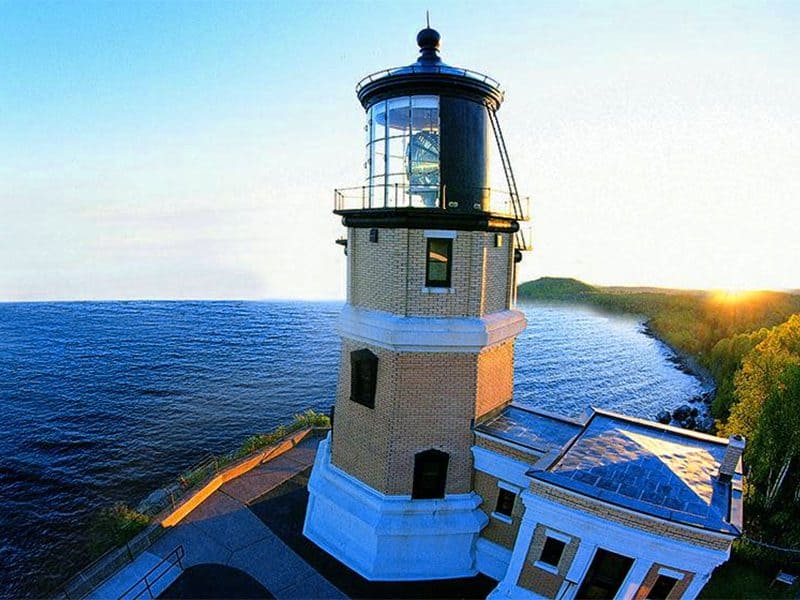
Split Rock, Minnesota (1910)
High on a Minnesota cliff overlooking Lake Superior stands one of the world’s loveliest edifices. It’s the yellow-brick tower of the Split Rock Lighthouse. Photographed millions of times, framed in countless postcards, and featured on the covers of hundreds of publications, it is undoubtedly one of America’s best-known and most visited lighthouse destinations.
Surprisingly, this old U.S. lighthouse is no longer an official Coast Guard light station. But that does not deter the visitors who swarm here every day during the summer to enjoy this magnificent structure and the spectacular view from its high, stony perch.
The octagonal tower is only 54 feet tall, but the cliff soars more than 120 feet over the lake. This places the light’s focal plane 168 feet above the lake and makes it one of the loftiest Great Lakes lighthouses. For additional information, visit the Minnesota Department of Natural Resources at www.dnr.state.mn.us/state_parks.
Split Rock Lighthouse
3713 Split Rock Lighthouse Road
Two Harbors, MN 55616
Tel: (218) 226-6372
Open: daily 10am-6pm
https://www.mnhs.org/splitrock
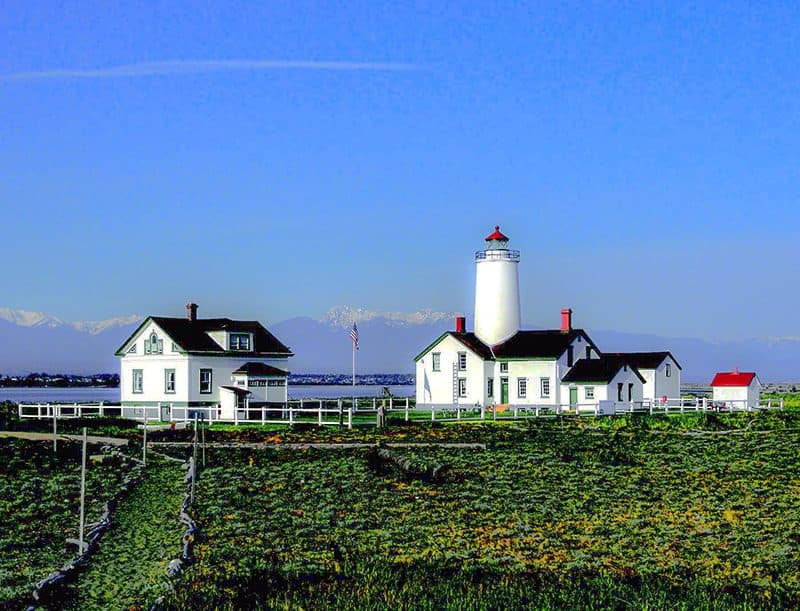
New Dungeness, Washington (1857)
A five-mile-long blade of sand known as the Dungeness Spit cuts northward from the Olympic Peninsula and threatens vessels moving through the Strait of Juan de Fuca. Rising only a few feet above high tide, the spit is also invisible to ships. To help prevent them from running aground, maritime authorities established the New Dungeness Lighthouse here in 1857.
Both this U.S. lighthouse and the spit took their names from Dungeness Point in England, coincidentally famed for its magnificent lighthouse. Like its British namesake, Dungeness Spit is also a ship killer; over the years, many vessels were lost in its sands. The list of ships wrecked on its sands is nearly endless. The New Dungeness Light, initially focused by a classic crystal lens, is now generated by a modern optic.
The lighthouse is accessible only by boat or a 5-mile hike along the scenic Dungeness Spit, a crucial part of the Dungeness Wildlife Refuge. This highly worthwhile adventure begins at the refuge parking area and takes about five hours roundtrip. But, importantly, you should only attempt the hike the in good weather at low tide. For more information, visit www.newdungenesslighthouse.org.
New Dungeness Lighthouse
Sequim, WA 98382
Tel: (360) 683-6683
Open: daily 9am-5pm
https://newdungenesslighthouse.com/
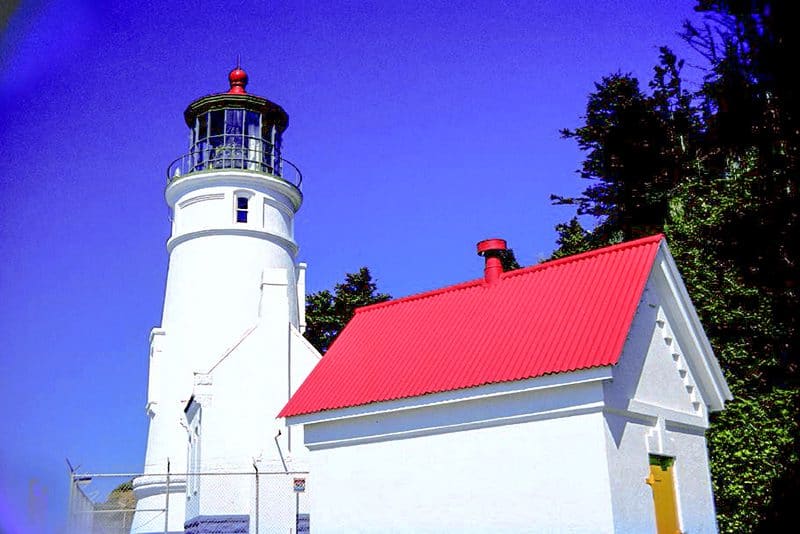
Heceta Head, Oregon (1894)
Establishing an unbroken string of maritime lights along the US West Coast took decades. One of the last dark stretches was 90 miles of bleak shoreline south of Newport, Oregon. The navigators of ships plying these waters found their way in the gloom, but in the spring of 1894, help arrived in the form of a bright maritime light shining from atop a 56-foot white masonry tower perched on the cliffs at Heceta Head.
The new Heceta Head Lighthouse had an exquisite first-order lens with 640 individual prisms. Originally, the light came from a five-wick coal-oil lamp, and a weighted cable powered the gears that turned the lamp, causing the light to flash. Although the old lamp has long since given way to a million-candlepower electric bulb, the original classic lens still shines. Its beam flashes seaward from an elevation of more than 200 feet and is visible from up to 21 miles.
Among the most scenic U.S. lighthouses in the West, Heceta Head is understandably popular with photographers. It has an additional treat in store for travelers as the historic keeper’s quarters now serve as a delightful bed-and-breakfast inn. For more information, visit www.hecetalighthouse.com.
Heceta Head Lighthouse
725 Summer Street
Florence, OR 97439
Tel: (800) 551-6949
Open: daily 11am-5pm
https://www.hecetalighthouse.com/

East Brother, California (1874)
Built in 1874, the classically Victorian East Brother Lighthouse now serves as a navigational light guiding vessel into San Pablo Bay. But it’s now also a famous bed-and-breakfast inn.
Located on a small island just off San Pablo Point, this U.S. lighthouse marks the channel through the narrow and often treacherous San Pablo Straits linking the Sacramento River estuary to the open waters of the San Francisco Bay.
Unable to buy property on the mainland at an acceptable price, the government resorted to building the station on tiny East Brother Island. Construction crews had to blast away much of the one-third-acre island to level the site. In fact, there was hardly room to squeeze the combination two-story tower and dwelling and separate fog signal building. In 1967 the Coast Guard decided to automate the station. The plan was to place its light on a pole, and tear down the old buildings. Local preservationists managed to save the structure and, over time, restore the station to its original Victorian charm. The fifth-order light is still in operation.
East Brother Lighthouse
1900 Stenmark Drive
Richmond, CA 94801
Tel: 510) 233-2385
Open: daily 9am-9pm
www.ebls.org
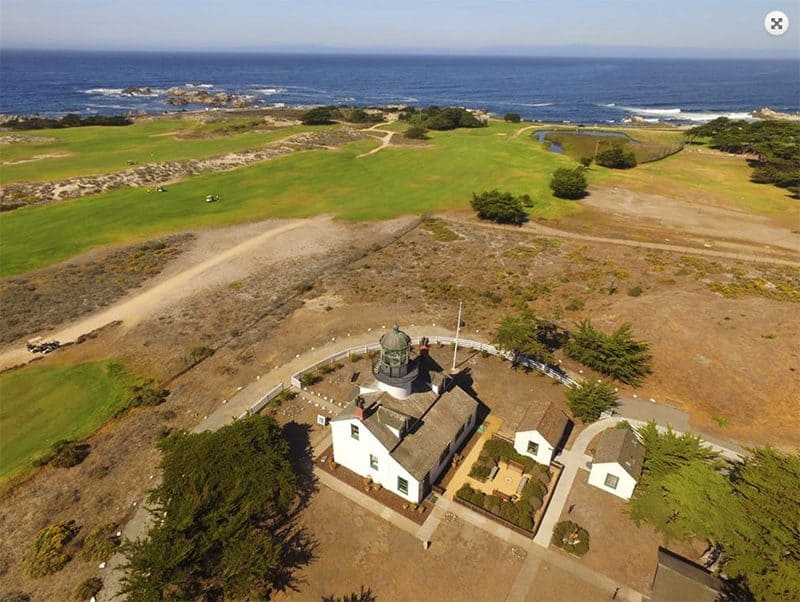
Point Pinos Lighthouse, California (1855)
Now surrounded by a lush golf course, the Coast Guard now leases the West Coast’s oldest active lighthouse to the Pacific Grove Museum of Natural History, which uses it as a maritime museum.
Like many other early California lighthouses built during the 1850s by contractor Francis Gibbons, this one consists of a Cape Cod–style stone keeper’s residence with a conical brick tower rising through its roof. Originally granite, the Point Pinos Lighthouse was covered with reinforced concrete following the severe earthquake that devastated San Francisco and much of the central California coast in 1906. The third-order Fresnel lens in place here since 1855 still shines.
Counted among the West’s most important historical treasures, this old U.S. lighthouse has played host to notables the likes of John Steinbeck and Robert Louis Stevenson. The station’s first keeper, former gold rush miner Charles Layton, died in a shoot-out with the notorious bandito Anastasio Garcia. Layton’s wife then took over as keeper.
While the lighthouse is open to the public only on Saturday and Sunday afternoons, it is viewable from many points along the Monterey Peninsula’s extraordinarily scenic Sunset Drive.
Point Pinos Lighthouse
80 Asilomar Avenue
Pacific Grove, CA 93950
Tel: (831) 648-5722
Open: Friday 1pm-3pm / Saturday-Sunday 11am-3pm / closed Monday-Thursday
https://www.pointpinoslighthouse.org/
Ray Jones’s books on lighthouses and other subjects may be purchased at your favorite bookstore or coastal gift shop. They can also be ordered directly from the publisher, Rowman & Littlefield Publishing Group.

Great list. Here’s one more for military buffs: the Pensacola Lighthouse & Maritime Museum on Naval Air Station Pensacola (built in 1859), so make sure you use the proper gate and all adults have a proper photo ID. It’s 177 steps to the top for a view of the base and the bay. This is actually the secondary attraction on NAS. The National Naval Aviation Museum, just down the road, is phenomenal. It’s like a Smithsonian with amazing displays and local docents who explain everything, often from firsthand experience. If you visit on the correct mornings (TUE & WED) during the Blue Angels practice months in spring and summer, you can also see their incredible aerial displays from NAS or nearby neighborhoods. Sometimes the BA pilots have a meet and greet session also. Wow!
Thank you Stan! A great addition to the list.
Jim